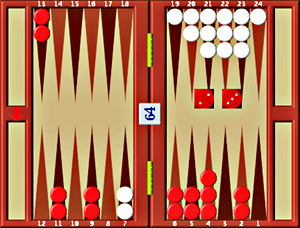Intermediate Strategies (continued)
Tutorials 2
17. Timing: pay attention to timing, especially in prime vs prime or backgame situations. Recycle checkers where you can.
Example: Here red has a serious backgame though no board really to speak of! 20/15 is the best move here which forces white to build higher towers on the 17-19 and 22 points, thus reducing his flexibility.
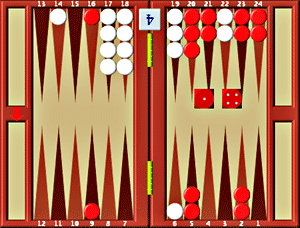
-
18. Golden points: there are two golden points on the board (and two silver!). Barclay Cooke writes in his book Paradoxes & Probabilities “The one basic early tactic which should supersede all others is to do everything in your power to make both 5-points, especially your opponent's as soon as possible - as long as you hold this point you can afford daring manoeuvres.”
Example: This is fairly typical of the early stages of a game where white is fighting to make his golden point. His best move here is bar/20 and 6/5.
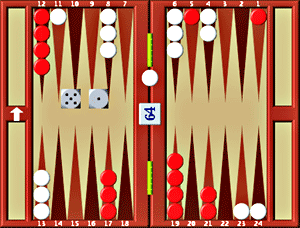
-
19. Golden points: don’t give up your opponent’s golden 5-point cheaply. Experienced players try to tempt beginners off the golden point. Weigh up the pros and cons of moving off it. It’s often ok to vacate it by hitting a blot early in the game or late in the game but not often in the middle of a game.
Example: in this example, red has the opportune moment to leave his opponent’s golden point. Leaving with both checkers ( 20/14 , 20/17) he is also setting up a variety of hit possibilities for when white rolls a 6-x.
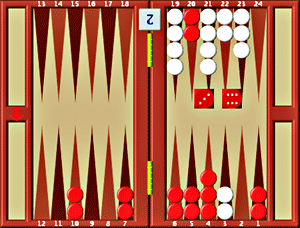
-
20. Double hits: never underestimate the power of a double hit.
Example: here white is behind in the race and has no board to talk of. His double hit on red’s pieces just now has yielded a result as red has just thrown one six. A double hit to the ace point (no. 24 here) sometimes smacks of desperation but can often help to even out pipcount imbalances and even sets up possible close out positions on occasions.
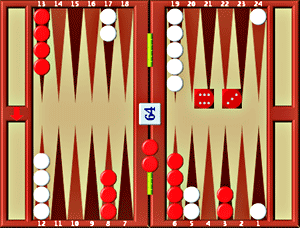
-
21. Priming games: in a priming game, build your prime first, then escape your back checkers.
-
22. Bearing off: when bearing off against a backgame (when your opponent has two of your home points anchored), build up your stacks rather than spreading them out. This will give you more flexibility and better timing.
Example: here white is facing a two point backgame but because of the building of stacks on the 21/22 points, he should be able to take off 8 checkers before offering a chance to be hit. Even if Red succeeded in hitting one of white’s checkers and closing him out in his own homeboard, White is still favourite.

-
23. Making mistakes: the biggest mistakes are not caused by making the wrong move but by not seeing the alternatives.
Example: in this example, a beginner might run his chequer 24/13 as he has so often in the past. A more advanced player may play safe with 24/18, 23/18. Yet the best move even in a "gammon-save" situation is aggressive: 13/7, 6/1.
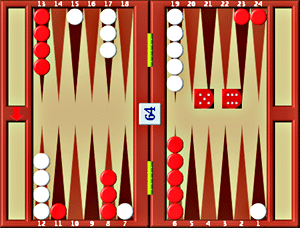
-
24. Board strength: if your board is stronger than your opponent’s, be bold.
-
25. Play rationally: don’t let your emotions dictate your moves.
-
26. Abandoning anchors: try not to abandon your last anchor cheaply (although there is a trade off versus ‘crunching your board’).
Example: here there is no need to abandon your anchor, even on a 6-x roll as timing still plays to you. Most likely is that white will have to abandon his own anchor or the 16 point with the next roll. Move a piece from the mid point.
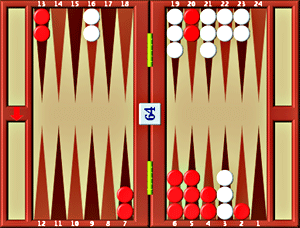
-
27. Hitting: when in doubt, hit!
Example: this is a clear case of coming in with the six and hitting back immediately on your one point as white will hit you next turn if he can. It also leaves open the possibility of priming him by making your 7 point soon.
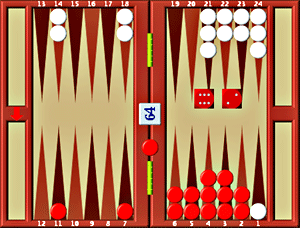
-
28. Doubling: when considering accepting a double, you should be able to win 25% of the games, if there is little risk of a gammon, to break even. Note that it also varies with match score (when behind be a little more aggressive, when ahead be a little more conservative).
-
29. Bearing off: aim for even numbers of checkers on your high points when bearing off against someone with pieces in your home board.
-
30. Bearing off: when bearing off, bear them off, don’t try to make your board prettier or more even.
Example: it might seem a simple one but there are plenty of beginners who like to even up their checkers, by moving two onto the two point as they have throughout the game in other situations before the end game. Just bear them off from the one point first.
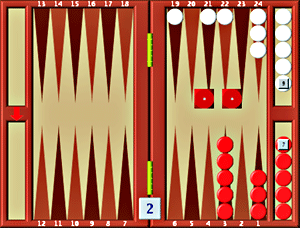
-
31. Gammons: try to weigh up the pros and cons of going for a gammon win.
-
32. Blitz games: in a blitz game, spread out your pieces for maximum chances of slotting more points in your homeboard or hitting a piece fresh off the bar.
Example: this is a typical blitz situation where you want to maximize your chances of hitting any checkers that white brings back onto your homeboard, or alternatively to fill in your missing points for a close out. Move 11/6, 13/7.
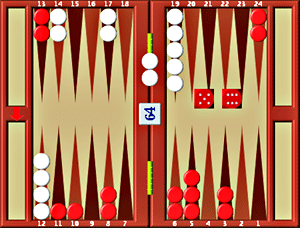
-
33. Building point: if you can’t move your builders fast enough, move the building point!
-
34. Hits in your home board: a risky loose hit in your home board has many advantages: it takes away flexibility from your opponent, there is a chance he cannot reenter and it gives you a chance of making a point in your board.
Example: here there is a choice of hitting your opponent’s piece in the outfield with the three or a loose hit on your golden point with the one. We Backgammon recommend the bar/22, 6/5.
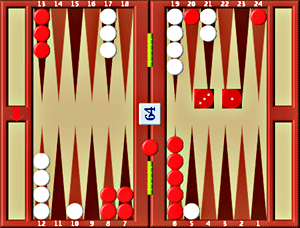
-
35. Leaving shots: pay now or pay later. Weigh up the pros and cons of leaving a shot for your opponent vs ‘crunching’ your board. Questions to ask include: Am I merely postponing the pain? Is my opponent’s homeboard improving? Am I home free if they miss me this time?
Example: red is behind on pipcount here with 104 vs White’s 80. Rather than starting to crunch the board, or to leave it in a disorganized state for white’s race home, red is better leaving a blot on his 11 spot. The best move here is 11/6. He also stands a chance of hitting one of White’s homeboard blots if hit himself. In brief, he’s leaving a blot but one which carries more risk for White than for Red.
